What Surface Technology Should You Choose for Custom Mugs?
This is an era where appearance matters, even a simple custom mug is getting a makeover. People aren’t just looking for a mug to hold their coffee—they want mugs that show off their personality, fit different occasions, and express their lifestyle. When you pick up a custom mug, what you notice first might be its smooth finish, shiny metallic look, or unique crackled texture. These effects come from processes like powder coating and electroplating. For brands and retailers, when all mugs do the same job, it’s the cool surface finishes that make custom mugs stand out. But, for those who want custom mugs, you may want to know what the price tag you have to pay during the manufacturing process.
Table of Contents
ToggleCustom Mugs Surface Finish Matters
With rising consumer expectations and a growing demand for personalization, competition in the custom mug market has moved beyond just functionality—it’s now a full-scale battle, with design and craftsmanship at its core.
For consumers, a mug’s appearance is more than just a look; it’s an emotional connection. A well-crafted custom mug not only delivers aesthetic pleasure but can also become a conversation starter in social settings, fulfilling deeper needs for identity and self-expression.
From a brand retailer’s perspective, unique surface technology is a powerful tool for differentiation. When multiple products offer similar functionality, innovative design and craftsmanship make a mug stand out, catch consumers’ attention, and drive both purchases and brand loyalty.
Surface performance isn’t just about looks—it fundamentally reshapes a mug’s overall product attributes. For manufacturers, the choice of surface technology directly impacts production costs, efficiency, and quality control. It drives investment in R&D and pushes innovation in materials, processing equipment, and design.
First, surface technology must align with functionality. For example, thin-wall designs make mugs lighter but may compromise heat retention. In such cases, material improvements or structural design adjustments are needed to balance performance. These trade-offs reflect a manufacturer’s ability to precisely position a product—should it prioritize portability or long-lasting insulation? Should it emphasize artistic appeal or practicality?
Second, surface technology directly affects costs and pricing potential. High-end customization, such as hand engraving, adds significant value but also costs several times more than standard techniques. Similarly, using multiple complex techniques increases production challenges, requiring careful supply chain and production line management. The key challenge for manufacturers is optimizing craftsmanship combinations to keep costs under control while creating unique selling points that enhance perceived value.
Beyond aesthetics, surface technology shapes user experience. The smooth feel of powder coating, the metallic shine of electroplating, and the striking effect of gradient colors all subtly influence consumer perception and emotional connection. A mug’s first impression is largely determined by its craftsmanship, making innovation in this area crucial for transforming a cold industrial product into something consumers feel connected to.
Given these multi-dimensional impacts, manufacturers must go beyond merely executing craftsmanship—they should become value creators for brands. By deeply understanding the relationship between craftsmanship and product attributes, they can offer the best material and design solutions, helping brands turn “great craftsmanship” into “great products.”
Common Surface Performance Techniques for Custom Mugs
Insulated coffee mugs have become a new trend, but choosing the right surface finish for stainless steel has become another challenge for the gifting industry. Since stainless steel is more expensive than ceramic and plastic, and there are more surface finishing technologies available for stainless steel, this decision becomes even more complex.
When it comes to stainless steel, surface technologies generally fall into three main categories:
Surface Finishing Techniques – These include coating, printing, and other methods that alter the mug’s color, texture, or gloss. This category is widely used for cost-effective customization while still allowing brands to enhance visual appeal and perceived value.
3D Decorative Techniques – Methods such as embossing or relief engraving create raised patterns and textures on the mug’s surface. These not only add depth and visual interest but also enhance the tactile experience.
Composite Techniques – Combining multiple surface treatments, such as layering coatings with engravings or inlays, results in unique, high-end finishes with artistic appeal.
Surface Finishing Technologis
Powder Coating
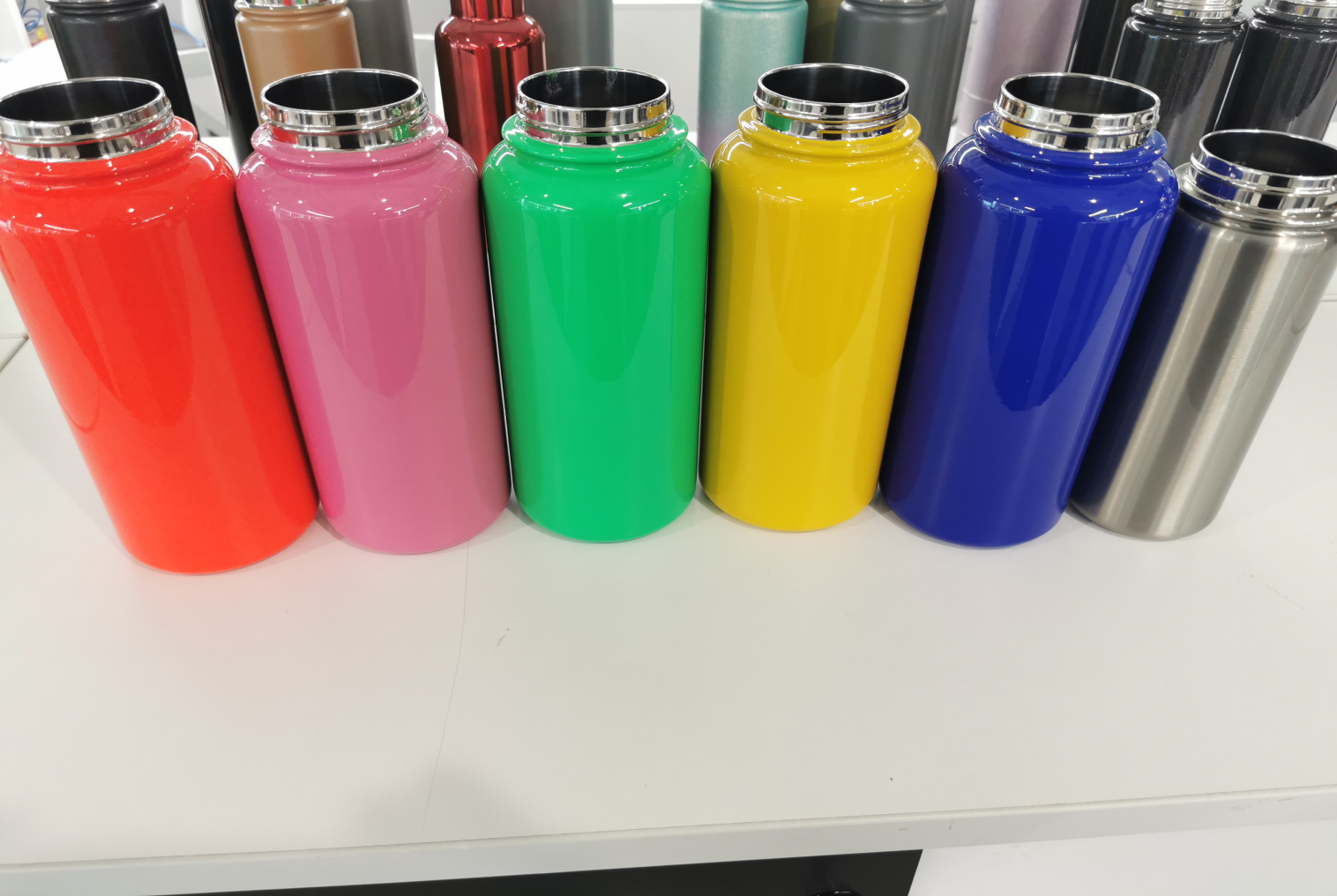
Appearance: Matte, frosted, or slightly textured finish, commonly used for solid or gradient colors. It provides a smooth and soft-touch surface that minimizes the industrial feel of metal, making it ideal for modern, minimalist designs.
Best for: Everyday mugs, office-use mugs, and sports mugs that require a slip-resistant grip.
Cost & Considerations: Moderate cost with high production efficiency. Single-color coatings are the most budget-friendly, but complex curved surfaces may lead to uneven thickness or an “orange peel” effect, affecting both appearance and insulation performance.
Electroplating

Appearance: High-gloss mirror-like finish or matte metallic shine, often associated with a premium, “luxury” look. The reflective surface is particularly eye-catching under lighting.
Best for: Business gifts, premium insulated mugs, and minimalist designs.
Cost & Considerations: 2-3 times the cost of powder coating. Best used on focal areas like lids or rims for a high-end touch. However, electroplated surfaces are prone to fingerprints and scratches, so an anti-smudge coating is recommended.
Heat Transfer & Water Transfer Printing
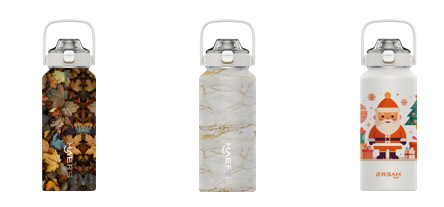
Appearance: Allows for detailed graphic designs, including photorealistic patterns, marble effects, and cartoon prints.
Best for: Custom mugs targeting younger markets or products that rely on strong visual impact.
Cost & Considerations: Flexible and highly customizable. Best for flat or slightly curved surfaces, as complex shapes may distort the transferred pattern.
3D Decorative Techniques
3D decorative techniques use physical shaping to make products more recognizable, focusing on design and personalization. These techniques enhance both visual and tactile experiences through three-dimensional structures but must balance aesthetics and functionality to ensure practicality.
Laser Engraving
Appearance: Creates fine, precise etching on metal or glass surfaces, ideal for logos, geometric patterns, or intricate textures.
Best for: Corporate gifts and premium custom mugs requiring a refined, branded touch.
Cost & Considerations: Long-lasting and durable. Pricing depends on the complexity of the design. Avoid deep engravings over large areas, as they may compromise the mug’s structural integrity.
Embossing & Relief Engraving

Appearance: Creates a 3D textured surface with natural depth, often resembling handcrafted details or organic patterns.
Best for: Mugs with a cultural or artisanal aesthetic, such as tea-themed designs or decorative homeware.
Cost & Considerations: Requires custom molds and design adjustments to balance ergonomics and usability. Embossed details should be placed in non-grip areas to maintain comfort.
Etching
Appearance: Produces soft-edged patterns or see-through effects, maintaining the material’s natural texture.
Best for: Vintage-style mugs or artistic collector’s items.
Cost & Considerations: Requires corrosion-resistant metals. Avoid using on mugs that frequently come into contact with acidic beverages.
Combined Techniques
By combining different techniques, we create unique product effects, making them ideal for brands that value individuality and innovation. While this approach enhances product value, it also increases production complexity and costs.
Laser Engraving + Anodizing
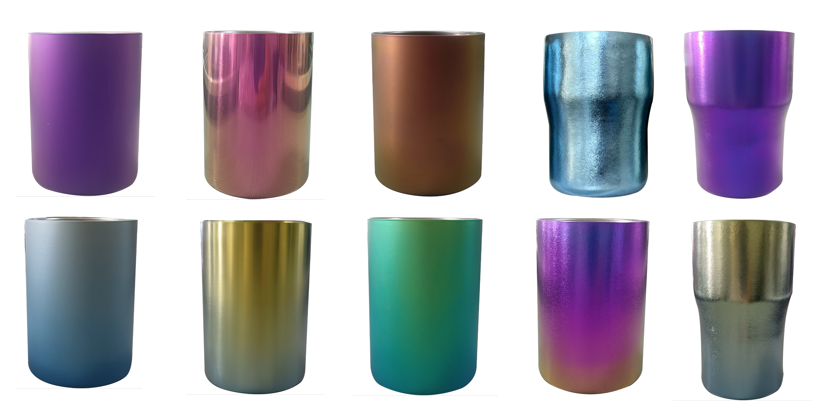
Appearance: Creates a striking contrast between the oxidized base color and engraved patterns, enhancing visual depth and durability.
Best for: Limited-edition and designer collaboration mugs that emphasize intricate detailing and light-reflecting effects.
Cost & Considerations: Requires high-end equipment and precise control over production. Longer processing times and a higher rejection rate make it best suited for premium, custom-made mugs.
PVD Coating + Rubberized or Ceramic Paint
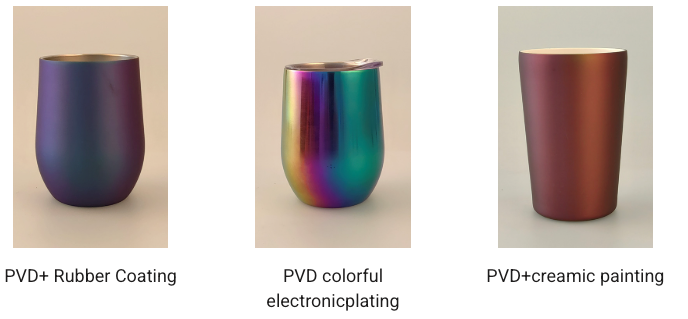
Appearance: A high-polish metal-like finish created by PVD coating, combined with a soft, fingerprint-resistant ceramic interior. The result is a durable, easy-to-clean mug with a luxurious feel.
Best for: Eco-conscious products, high-frequency use mugs (office, home), and premium collections such as baby-safe or health-oriented drinkware.
Cost & Considerations: Higher initial production costs due to food-safe materials and specialized curing processes. However, its long-lasting durability and easy maintenance make it a cost-effective investment for mid-to-high-end markets.
By leveraging different surface performance techniques, manufacturers can create custom mugs that cater to diverse market demands—whether prioritizing affordability, luxury appeal, or functional innovation.
Surface Technology Price Ranges When Custom Mugs
Manufacturers of custom mugs must tailor their surface performance techniques based on target consumer affordability and market positioning. Pricing strategies generally fall into three categories: budget-friendly, eye-catching mid-range, and high-end luxury. Each segment demands a balance between cost control and perceived value enhancement.
Budget-Friendly Choice:
For price-sensitive consumers, the key is to create the highest perceived value at the lowest cost. Budget-friendly custom coffee mugs typically range from $5 to $20, prioritizing affordability while maintaining aesthetic appeal. This segment relies on well-established, cost-efficient surface performance techniques.
Powder coating is a primary choice in this category—it offers matte or frosted finishes that conceal the industrial look of the base material while providing a smooth, slip-resistant texture. The result is a minimalist yet premium appearance. This technique is widely used in Haers’ product line, ensuring a competitive price point while allowing for a variety of standard color options.
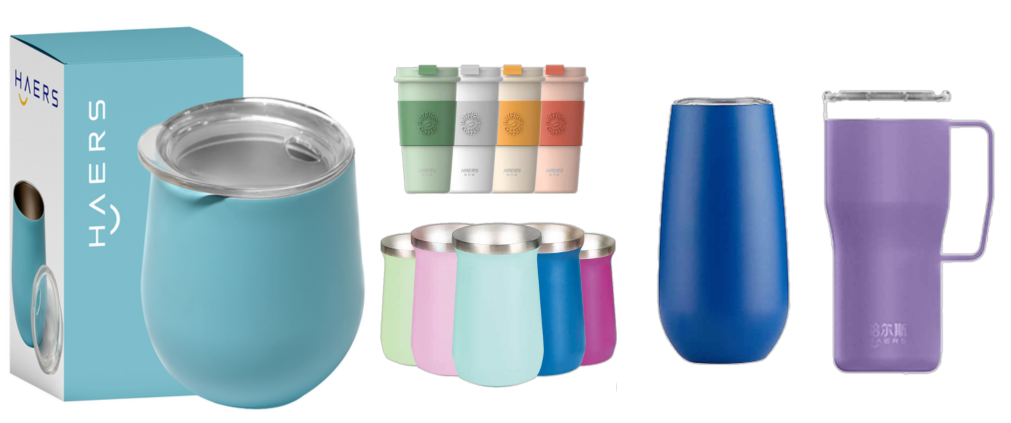
For brand customization, powder coating combined with screen printing is an effective choice. Screen printing allows for the application of logos or simple geometric designs with strong ink adhesion and long-lasting colors, enhancing brand recognition without significantly increasing costs. This technique is also highly adaptable, enabling manufacturers to quickly switch designs for different market needs.
For a more intricate visual effects, heat transfer printing provides an alternative. By transferring pre-printed patterns onto the mug’s surface using heat or water activation, manufacturers can achieve complex gradient designs or multi-color decorations that traditional screen printing cannot replicate. This technique is particularly useful for seasonal themes or small-batch customization, offering brands a competitive edge in personalization.
Eye-Catching Custom Mugs
In the mid-range category ($20–$50), consumers seek more than just functionality—they want custom mugs that stand out. At this price point, unique surface performance techniques create a strong visual impact and add a sense of individuality. Haers has developed diverse solutions in this segment, particularly for its popular large-capacity travel tumblers.
One standout technique is the nano ice-crackle finish. This innovative coating forms intricate frost-like patterns on the mug’s surface, creating a striking three-dimensional effect under light. When combined with UV printing, the depth and contrast of the colors are further enhanced, making the design even more vibrant.
Haers also offers a variety of other nano-textured surface finishes, including nano-feather, nano-sand, nano-pearl, and nano-seaweed patterns, each delivering a distinctive tactile and visual experience.
Electroplating is another premium option in this category, adding a sleek metallic finish to custom mugs. Beyond standard mirror-like silver or chrome plating, Haers provides multi-color electroplating options in hues such as iridescent blue, gold, antique bronze, and deep red. When combined with brushed or etched textures, this technique creates a multi-layered aesthetic, making it an excellent choice for brands looking to differentiate their products.
Gradient spray coating further enhances visual appeal by seamlessly blending colors across the mug’s surface. By precisely adjusting spray gun pressure and paint formulations, manufacturers can achieve smooth color transitions that break away from the monotony of solid-colored coatings. This dynamic surface performance not only elevates the perceived quality of the product but also strengthens brand identity.
High-End Luxury Custom Mugs
Luxury custom mugs ($50 and above) are more than just drinkware—they embody craftsmanship and exclusivity. This segment focuses on rare materials and intricate techniques to create emotional value, making each piece feel like a work of art.
Premium titanium mugs exemplify this approach. Haers’ Titanium Life series, known as the “luxury of drinkware,” combines pure titanium construction with PVD coating, emphasizing the natural elegance of metal while enhancing durability. Despite its minimalist aesthetic, this design philosophy relies on the inherent value of the material itself, making each piece a statement of refined taste.
Advanced techniques like color titanium anodization allow for the creation of vibrant, multi-layered hues unique to titanium. Since these colors are achieved through light refraction rather than pigments, they cannot be custom-mixed, adding to their exclusivity. Similarly, antique red lacquer provides a vintage, richly textured finish that shifts in tone under different lighting conditions, giving each mug a unique character. These processes require meticulous application, often involving multiple coating layers and fine-tuning to achieve the desired effect.
For the pinnacle of luxury, handcrafting techniques add a level of artistry unattainable by mass production. Enamel painting fuses glass-based pigments with the mug’s surface through high-temperature firing, resulting in a jewel-like finish often reserved for museum collaborations. Hand-engraved gold inlay involves skilled artisans carving microscopic patterns into metal before embedding gold leaf, a process that can take hundreds of hours per piece. These labor-intensive methods create one-of-a-kind collector’s items, often available only through custom orders.
Key Factors in Choosing Surface Technology
When selecting the appropriate surface performance for custom mugs, cost is an important consideration, but it is far from the only factor.
Usage Scenarios
Different usage scenarios require different surface performance solutions. Outdoor sports mugs, for example, must prioritize durability. Since they frequently come into contact with carabiners and backpack linings, a high-hardness surface finish is essential to prevent wear and tear. Office mugs, on the other hand, can focus more on aesthetics, incorporating visually striking finishes. For baby and maternity products, safety takes precedence—every surface treatment must be food-grade certified, and coatings containing heavy metals should be strictly avoided.
Production Volume & Lead Time
For large-scale production, high mold costs can be justified by lower per-unit costs. While mold setup expenses may reach thousands of dollars, the additional cost per unit is minimal when spread across a high-volume order. In contrast, small-batch custom orders are better suited for surface performance techniques that do not require molding, allowing brands to avoid substantial upfront investment.
When dealing with urgent orders, such as seasonal or holiday-limited editions, manufacturers should prioritize fast production techniques with shorter processing times. Multi-layered surface treatments generally require more time than single-layer finishes, making them less suitable when lead times are tight.
Material Compatibility
Different mug materials are compatible with different surface performance techniques. Some metals work well with electroplating or spray coating, while others are better suited for laser engraving or heat transfer printing. Understanding material compatibility ensures optimal durability and appearance.
As a 25-year water bottle manufacturer in the drinkware industry, Haers has accumulated extensive expertise in surface performance solutions. From cost-effective powder coating and screen printing to high-end, intricate finishes, we offer a full spectrum of choices to meet diverse budget and design needs. Our value extends beyond the numbers on a price quote—we analyze material properties, production timelines, and market trends to help clients assess hidden costs and long-term benefits.
The best surface performance choice is always one that enables brands to enhance perceived value within their target market while maintaining cost efficiency and minimizing risk. This balance between short-term cost control and long-term product viability is the true essence of sustainable manufacturing.

